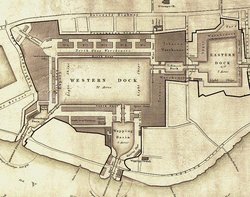London Docks
|
|
The London Docks were one of several sets of docks in the historic Port of London. Traditionally ships had docked at wharves on the River Thames itself, but this time, more capacity was needed. They were constructed in Wapping just downstream from the City of London in 1805. They were the closest docks to the City of London, apart from St Katharine Docks, which were built two decades later.
The London Docks occupied a total area of about 30 acres (120,000 m²), divided into western and eastern basins linked by the short Tobacco Dock. The principal designers were the architects and engineers David Alexander and John Rennie. The docks specialised in high-value luxury commodities such as ivory, spices, coffee and cocoa as well as wine and wool, for which elegant warehouses and wine cellars were constructed. In 1864 they were amalgamated with St Katharine Docks.
The docks were finally closed to shipping in 1969 and sold to the borough of Tower Hamlets, which filled in the western portion of the London Docks with the (unrealised) intention of turning them into public housing estates. The land was still largely derelict when it was acquired in 1981 by the London Docklands Development Corporation (LDDC). It was subsequently redeveloped with over 1,000 individual properties centred around the old Tobacco Dock and the surviving eastern basin, renamed Shadwell Basin. The controversial "Fortress Wapping" printing works of Rupert Murdoch's News International corporation was constructed directly on top of the infilled western basin.


